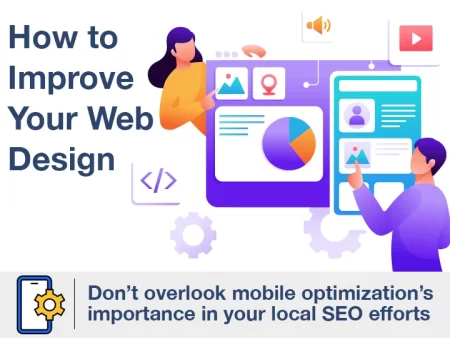 Within the first five seconds that someone lands on your website, they’ll want to know what your business is about and how to easily find what they’re looking for. Having this information readily available for your visitors will enable you to have a low bounce rate, which means you’ll do better when it comes time to rank for local SEO. If your web design isn’t lending itself to accomplishing these things for you, here are some tips to help you steer it in the right direction.
Within the first five seconds that someone lands on your website, they’ll want to know what your business is about and how to easily find what they’re looking for. Having this information readily available for your visitors will enable you to have a low bounce rate, which means you’ll do better when it comes time to rank for local SEO. If your web design isn’t lending itself to accomplishing these things for you, here are some tips to help you steer it in the right direction.
Make sure you know what you want your website to do for you.
Your first step is to map out your customer journey from the moment someone arrives at your site to the moment that they become a customer. Consider what pages you want them to see, what content you want them to review, and what offers will convert them into customers. This information will help you create a web design that nurtures your leads throughout the sales funnel. You also need to remember that bounce rate factors into your local SEO and where your web design lands you in the SERPs (search engine results pages).
Remove any distractions from your customers’ journey.
There are some elements of your web design that are bound to detract from your site’s value and message (e.g., complicated animation, lengthy content, “stock” photos). Remember, your audience only has an attention span of 8 minutes. This is the amount of time you must get your message across to them and convert them into paying customers.
Don’t overlook mobile optimization’s importance in your local SEO efforts.
Local SEO is vital to your website, especially if you own a small business. Therefore, you need to pay attention to what the search engines find important. One of the factors that they use in ranking you in the SERPs is the mobile optimization of your web design. Today, 80% of those who are using the internet today are doing so on their smartphones. In fact, Google has discovered that 61% of users won’t return to your website if they have difficulty reaching it while on their smartphone. Of this percentage, 40% will visit your competition’s website instead. This is a lot of traffic for you to be missing out on simply because you don’t have a responsive design for your website.
Once you get customers through your local SEO, you’ll need a strong call-to-action (CTA).
Use a strong CTA to guide your website visitors to where you want them to go so you can nurture them to conversion. Most internet visitors are lazy, so you’ll need to make this process easy for them. Do this by pointing them in the right direction and putting what you want them to see directly in front of them. In other words, you should be placing your CTA strategically throughout your website (e.g., in the top right corner of your navigation bar, below an area that requires some type of action, at the bottom of each website page). Make sure you also remember to meet each visitor where they are in their sales funnel journey, so you don’t lose people who aren’t quite ready to make a purchase.
Ultimately, what you should know is this…
Implementing these web design tips will bring about dramatic changes in how your website performs, the experience people have while there, and ultimately your bottom line. While all this can be intimidating, it’s a good idea to have a professional look at your website. We’re here for you at the Local SEO Tampa Company in Tampa, FL. We can help you determine what to do with your web design so your local SEO can help you rank higher in the SERPs (search engine results pages), so contact us today.
